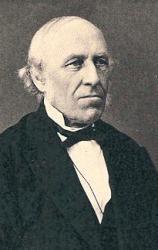Planning worship?
Check out our sister site, ZeteoSearch.org,
for 20+ additional resources related to your search.
- |
User Links
Person Results
Anonymous
Person Name: Ukjendt Paraphraser of "O Jesus, du er min!" in Salmebog for Lutherske Kristne i Amerika In some hymnals, the editors noted that a hymn's author is unknown to them, and so this artificial "person" entry is used to reflect that fact. Obviously, the hymns attributed to "Author Unknown" "Unknown" or "Anonymous" could have been written by many people over a span of many centuries.
Anonymous
Ludvig Mathias Lindeman

1812 - 1887 Person Name: Ludv. M. Lindeman Composer of "[O Jesu, du er min!]" in M. B. Landstads Kirkesalmebog og "Nokre Salmar" ved Professor Dr. E. Blix, samt følgende tillæg Ludvig M. Lindeman (b. 1812; d. 1887) was a Norwegian composer and organist. Born in Trondheim, he studied theology in Oslo where he remained the rest of his life. In 1839 he succeeded his brother as the organist and cantor of Oslo Cathedral, a position he held for 48 years up until his death. Lindeman was appointed Knight of the Royal Norwegian Order of St. Olav, and was invited to both help christen the new organ in Royal Albert Hall in London, as well as compose for the coronation of King Oscar II and Queen Sophie of Sweden. In 1883, he and his son started the Organist School in Oslo. Lindeman is perhaps best known for his arrangements of Norwegiam folk tales; over the course of his life he collected over 3000 folk melodies and tunes.
Laura de Jong
Ludvig Mathias Lindeman
Heinrich Georg Neuss
1654 - 1716 Person Name: Henrik Neusz Author of "O Jesus, du er min!" in Salmebog for Lutherske Kristne i Amerika Neuss, Heinrich Georg, son of Andreas Neuss, surgeon at Elbingerode in the Harz, was born at Elbingerode, March 11, 1654, and entered the University of Erfurt in 1677 as a student of theology. In 1680 he became a private tutor at Heimburg, near Blankenburg, and then in 1683 conrector, and in 1684 rector of the school at Blankenburg in the Harz. In 1690 he was appointed assistant preacher at Wolfenbüttel, and soon afterwards diaconus of the Heinrichstadt church there. For holding prayer meetings, &c, he was denounced as a Pietist, and chose to resign rather than desist. In the same year, 1692, he became preacher at Hedwigsburg, and travelling Chaplain to Duke Rudolph August of Brunswick, who, at Easter, 1695, appointed him superintendent at Remlingen for the district of Asseburg. In 1696 he received the degree of D.D. from the University of Giessen, and became superintendent, consistorialrath, and chief pastor of the Church of Saints Sylvester and George at Wernigerode, being instituted on Feb. 6. His appointment there was at first unpopular, for he was suspected of Separatist tendencies, but he soon gained the love of the people by his earnest and loving practical Christianity, and by the interest he took in the development of Church music, for which under his care Wernigerode became famous in all the district. He died at Wernigerode, Sept. 30, 1716 (Koch, iv. 425; Allgemeine Deutsche Biographie xxiii. 556; Heinrich Georg Neuss. By Ed. Jacobs. In the Zeitschrift des Harz-Vereins, vol. xxi. 1888, p. 159, &c).
The hymns of Neuss appeared principally in his Heb-Opfer zum Bau der Hütten Gottes, das ist, Geistliche Lieder, &c.; of this the first edition with 100 hymns was published at Lüneburg, 1692; and the 2nd edition, with 34 additional, at Wernigerode, 1703 [both in Berlin], most of the pieces bearing the dates of their composition. They were re ceived with great favour in Pietist circles, and Freylinghausen in his Geistreiches Gesang-Buch included no less than 38 (5 in pt. i., 1704; 33 in pt. ii., 1714). In the Werni¬gerode Gesang-Buch, 1712, edited by Neuss, 5 are included, and 5 more in the ed. of 1735. Only a few are found, in recent German collections. The 1703 edition of the Heb-Opfer had also 86 melodies, of which some 15 were by Neuss, and of these 15 passed into Freylinghausen's Gesang-Buch. In 1706 Neuss also published a collection of Brunnen-lieder at Pyrmont, for the frequenters of the Baths there.
Only one of his hymns has passed into English, viz.:—
Ein reines Herz, Herr, schaff in mir. Sanctification. A simple and beautiful hymn, first published in the 2nd edition, 1703, of his Heb-Opfer, p. 217, in 5 st. of 4 1. In the Berlin Geistliche Lieder, edition 1863, No. 380.
Translated as:—
A new and contrite heart create. A good and full translation by Miss Cox, in her Sacred Hymns from the German, 1841, p. 153 (1864, p. 177), repeated in the Baptist Hymnal, 1879.
Another translation is:—- "Lord! grant a newborn heart to me," by Lady E. Fortescue, 1843, p. 58. [Rev. James Mearns, M.A.]
--John Julian, Dictionary of Hymnology (1907)
Heinrich Georg Neuss


 My Starred Hymns
My Starred Hymns


